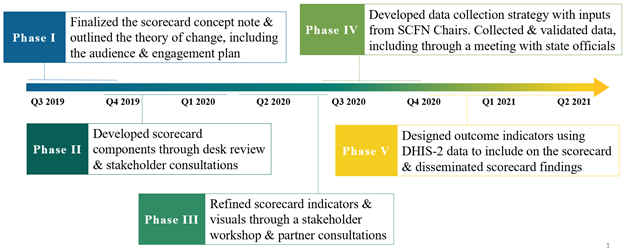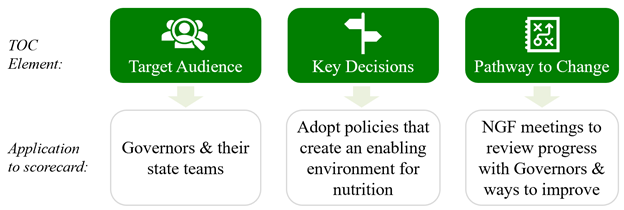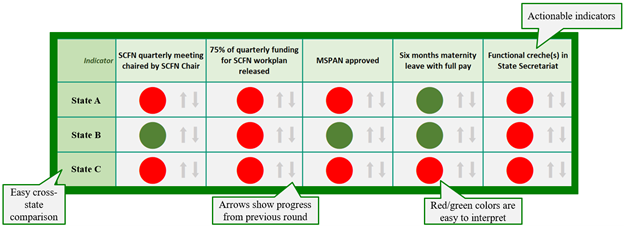By: Oluwagbenga Sadik & Caroline Snead
The Nigerian Governors’ Forum (NGF) is a non-partisan policy-hub dedicated to promoting good governance and development at the sub-national level. The forum has a strong track record of using data to inform decision-making and improve advocacy among Nigeria’s Governors. For example, the NGF designed and implemented several state-level scorecards to engage Governors around key policy issues including polio eradication, state-supported health insurance schemes, and release of basic health care provision funds . With nutrition as a priority commitment, the forum has been part of several efforts to advance the nutrition agenda in Nigeria. The NGF nutrition scorecard is a recently developed data visualization tool (DVT) that will hold the state Governors accountable to key nutrition commitments and motivate them to act. In this article, we describe the scorecard development process with the aim of sharing lessons learned.
In developing the scorecard (Figure 1), the collaborative design team, with members from the NGF health policy unit and DataDENT, engaged Governors, state and federal level multi-sector nutrition bodies, and development partners to identify the key nutrition commitments that will shape the enabling environment for nutrition in Nigeria. The commitments include:
1. To set up or revitalize State Committees on Food and Nutrition (SCFN);
2. To establish state-level multi-sectoral plans of action on nutrition (MSPAN);
3. To increase budgetary spending on nutrition interventions; and
4. To promote maternity protection for civil servants.
The commitment indicators, and other scorecard components were then developed in consultation with state representatives and partners.
Figure 1: Scorecard Development Process

Throughout the scorecard design process, the team noted several key reflections to help inform others interested in developing similar accountability DVTs.
1. Start with a clear theory of change, including an explicit understanding of who the target user group is and how the tool will influence their actions.
The theory of change (TOC) of a DVT articulates the goal of the tool and the mechanism by which it will achieve that goal among its target audience . Before activities were initiated, we mapped out three critical elements of the scorecard’s TOC (Figure 2).
Figure 2: Mapping the Scorecard’s TOC

The scorecard’s ultimate goal is to create an enabling environment for nutrition to improve nutrition outcomes in all 36 states. The Governors and their state teams (e.g., SCFN, State Commissioners of Health, Agriculture) are the primary audience as they have the mandate to enact and implement essential nutrition policies (e.g. 6-month maternity leave, establish and convene a SCFN). The NGF team presents the scorecard to the Governors during quarterly meetings and then actively engages individual Governors in follow-up to these meetings. The NGF provides state-specific recommendations on key actions that the Governors can take to improve their performance on the scorecard. For example, if a state has developed an un-approved multi-sectoral plan, the NGF team will recommend that the Governor review and sign off on the plan. Additionally, the NGF facilitates collaborative dialogues between states and development partners who provide technical assistance.
2. Select indicators that reflect the quality of policy implementation
The design team chose indicators that reflected not just the presence of a policy in support of the commitment, but the quality of policy implementation. For example, the maternity protections commitment included placing creches in government offices. Rather than a simple ‘present’ versus ‘not present’ indicator, the team developed an indicator that reflected provision of high-quality child-care services at the state-run creches. The Nigerian National Policy on Child Centers was referred to, in consultation with local partners, to select the key elements of a creche that are crucial to its proper functioning, (e.g. ratio of nannies to children). The trade-off is that these data require additional resources to collect for the quarterly updates; this added burden over time must be considered in indicator development.
3. Engage target users when selecting indicators because this engagement can build commitment to action
In order to select and define the scorecard indicators, the design team asked Governors, state-level teams, and other stakeholders to identify barriers to progress and then proposed indicators focused on those obstacles. For example, one barrier to the SCFN commitment was the lack of regular meetings despite the mandate to do so. The SCFN commitment indicator identifies whether the committee met in the previous quarter with the chairperson present. By creating this indicator, regular occurrence of the SCFN meetings, chaired by the Permanent Secretary of the Ministry of Budget and Planning was elevated to an indicator that is publicly reviewed on quarterly basis. The co-creation process engendered ownership of the indicator by the target audience, who will use it for decision-making. In this case, the design team developed unique fit-to-purpose indicators that are actionable (i.e. they can be influenced by the Governors) but in other scenarios, it may be preferable to align indicators with the established national or global definitions.
4. Allow the purpose and audience to dictate key design features of the DVT
Governors, state-level policy teams, and other nutrition stakeholders were engaged through individual consultations and workshops in order to agree on key features of scorecard design including types of indicators, the level of data displayed, and formatting (Figure 3).
Figure 3: Scorecard format with key design features highlighted.

The design team selected indicators that were actionable to the Governors and developed binary definitions (yes/no) displayed using two colors for easy comprehension. To facilitate comparison across states, only a subset of the tracked indicators are displayed on the scorecard shown during NGF meetings. Arrows in each cell show the direction of progress since the last quarter.
Looking Ahead
The scorecard was successfully launched with the Governors in April 2021, and states have made commitments to improve the indicators in the scorecard. Although there were some data gaps (e.g. not all states had data for all indicators), the first round showed the willingness of states to collect and share the indicators, a process that we expect to become easier over time. The process was driven and led by the NGF, with contributions from similar initiatives, which suggests that this will be a sustainable approach to advocate for a stronger enabling environment for nutrition and to hold states accountable to their commitments. It will also improve multi-sectoral nutrition planning and motivate other sectors to focus on nutrition through the multi-sectoral nature of the commitments.
In the next phase of this initiative, the design team will evaluate use of the scorecard including progress made by the states in the commitment areas, and also expand the commitment indicators to include state-level resource tracking. A comprehensive case study, detailing the entire process of developing the scorecard, will be published for the purpose of knowledge sharing.
Acknowledgment
We are grateful to Ahmad Abdulwahab, Agi Oka Grace and Gianni Dongo at the Nigeria Governors’ Forum, Yashodhara Rana, Albertha Nyaku, Augustin Flory, Arja Huestis, and Lexi Farina at Results for Development, and Rebecca Heidkamp and Riley Auer at Johns Hopkins University for their inputs in the conception, design and development of the nutrition scorecard project and thoughtful contributions to this article.
Citations
- Manorat, Renee, Laura Becker, and Augustin Flory. “Global Data Visualization Tools to Empower Decision- Making in Nutrition.” Sight and Life Magazine, 2019.
- Nigeria Governors’ Forum. “Achievements.” Nigeria Governors’ Forum, 2016. https://www.nggovernorsforum.org/index.php/the-ngf/about-the-ngf/achievements.
Authors
Oluwagbenga Sadik & Caroline Snead



